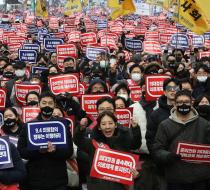Doctor Protests in South Korea Favorite
For more than a week, procedures at some of the largest hospitals in South Korea have been disrupted because thousands of medical interns and residents walked off their jobs. A prolonged walkout could have disastrous consequences.
The dispute started in early February, when the government proposed admitting more students to medical schools to address a longstanding shortage of physicians in South Korea. Interns and residents, known as trainee doctors, countered by saying that the shortage was not industrywide but confined to particular specialties, like emergency care. They said the government’s plan would not solve that problem, adding that they were victims of a system rife with harsh working conditions and low wages.
The doctors then took to the streets to the protest the plan, threatening to strike or quit their jobs. By and large, senior doctors backed their younger colleagues’ claims. But with surveys showing broad public support for beefing up the ranks of physicians, the government did not budge. Some saw the doctors’ pushback as a tactic to increase their paychecks.
Trainee doctors — who are a crucial part of large hospitals — started submitting their resignations on Feb. 19. As of Wednesday, nearly 10,000, or about 10 percent of all doctors in the country, had done so, according to government data. But most of these resignations have not been accepted by hospitals.
“It is impossible to justify collective action that takes people’s health hostage and threatens their lives and safety,” President Yoon Suk Yeol told reporters on Tuesday.
His government has said that if the doctors return to their jobs by Thursday, they would not face any legal repercussions. Otherwise they could risk losing their medical licenses and face fines of up to 30 million won ($22,000). The Health Ministry this week filed police complaints against a handful of doctors, accusing them of violating medical law.
As of Thursday morning, nearly 300 doctors had returned to work, according to the ministry. But with most trainee doctors still off the job, the dispute shows no signs of resolution.
The need for more doctors in South Korea is acute, the government says, especially given its rapidly aging population. It has about 2.6 doctors for every 1,000 people, compared with an average of 3.7 in the countries belonging to the Organization for Economic Cooperation and Development.
Earlier this month, the Health Ministry proposed increasing medical school admissions to about 5,000 students a year, from 3,000, starting in 2025. It would be the first increase since 2006 and, the government said, would mean an extra 10,000 doctors in a decade. The government also pledged to spend over 10 trillion won to improve essential services throughout the country, especially health care in rural areas.
Doctors argue that increasing the number of medical students will do little to change the status quo. A similar attempt by Mr. Yoon’s predecessor, in 2020, to increase the number of doctors resulted in a physician walkout that lasted a month. The government ended up shelving the expansion.
(From Jin Yu Young)







